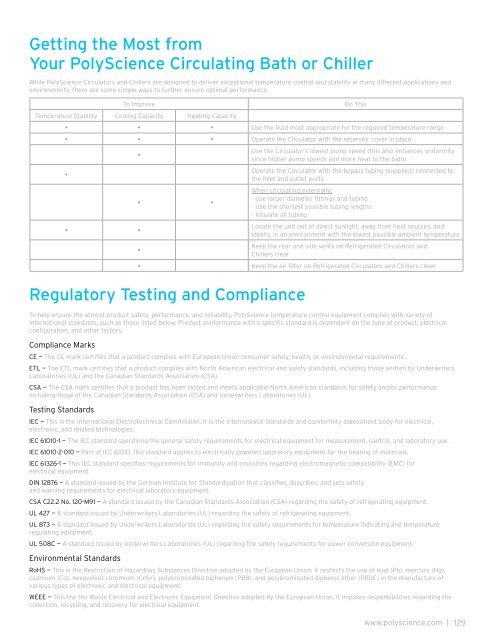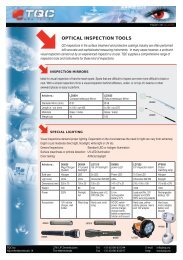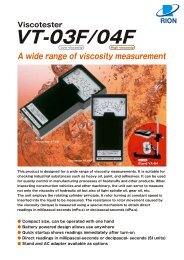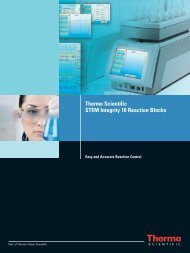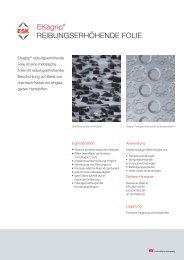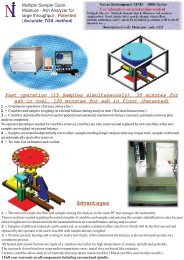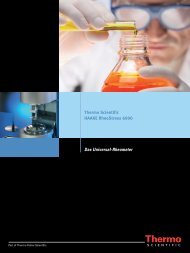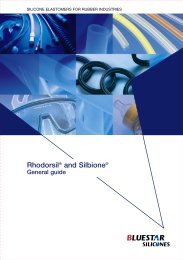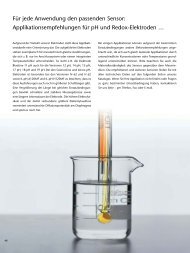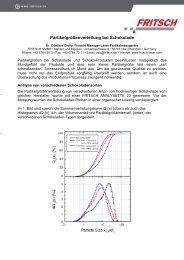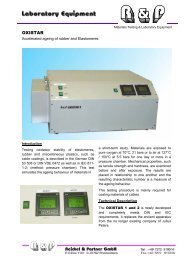Temperature Control Solutions - Labo Plus
Temperature Control Solutions - Labo Plus
Temperature Control Solutions - Labo Plus
Create successful ePaper yourself
Turn your PDF publications into a flip-book with our unique Google optimized e-Paper software.
Getting the Most from<br />
Your PolyScience Circulating Bath or Chiller<br />
While PolyScience Circulators and Chillers are designed to deliver exceptional temperature control and stability in many different applications and<br />
environments, there are some simple ways to further ensure optimal performance.<br />
To Improve Do This<br />
<strong>Temperature</strong> Stability Cooling Capacity Heating Capacity<br />
• • • Use the fluid most appropriate for the required temperature range<br />
• • • Operate the Circulator with the reservoir cover in place<br />
•<br />
• •<br />
•<br />
• •<br />
•<br />
Use the Circulator’s lowest pump speed (this also enhances uniformity<br />
since higher pump speeds add more heat to the bath)<br />
Operate the Circulator with the bypass tubing (supplied) connected to<br />
the inlet and outlet ports<br />
When circulating externally:<br />
- Use larger diameter fittings and tubing<br />
- Use the shortest possible tubing lengths<br />
- Insulate all tubing<br />
Locate the unit out of direct sunlight, away from heat sources, and<br />
ideally, in an environment with the lowest possible ambient temperature<br />
Keep the rear and side vents on Refrigerated Circulators and<br />
Chillers clear<br />
• Keep the air filter on Refrigerated Circulators and Chillers clean<br />
Regulatory Testing and Compliance<br />
To help ensure the utmost product safety, performance, and reliability, PolyScience temperature control equipment complies with variety of<br />
international standards, such as those listed below. Product conformance with a specific standard is dependent on the type of product, electrical<br />
configuration, and other factors.<br />
Compliance Marks<br />
CE — The CE mark certifies that a product complies with European Union consumer safety, health, or environmental requirements.<br />
ETL — The ETL mark certifies that a product complies with North American electrical and safety standards, including those written by Underwriters<br />
<strong>Labo</strong>ratories (UL) and the Canadian Standards Association (CSA).<br />
CSA — The CSA mark certifies that a product has been tested and meets applicable North American standards for safety and/or performance,<br />
including those of the Canadian Standards Association (CSA) and Underwriters <strong>Labo</strong>ratories (UL).<br />
Testing Standards<br />
IEC — This is the International Electrotechnical Commission. It is the international standards and comformity assessment body for electrical,<br />
electronic, and related technologies.<br />
IEC 61010-1 — The IEC standard specifying the general safety requirements for electrical equipment for measurement, control, and laboratory use.<br />
IEC 61010-2-010 — Part of IEC 61010, this standard applies to electrically powered laboratory equipment for the heating of materials.<br />
IEC 61326-1 — This IEC standard specifies requirements for immunity and emissions regarding electromagnetic compatibility (EMC) for<br />
electrical equipment.<br />
DIN 12876 — A standard issued by the German Institute for Standardization that classifies, describes, and sets safety<br />
and warning requirements for electrical laboratory equipment.<br />
CSA C22.2 No. 120-M91 — A standard issued by the Canadian Standards Association (CSA) regarding the safety of refrigerating equipment.<br />
UL 427 — A standard issued by Underwriters <strong>Labo</strong>ratories (UL) regarding the safety of refrigerating equipment.<br />
UL 873 — A standard issued by Underwriters <strong>Labo</strong>ratories (UL) regarding the safety requirements for temperature indicating and temperature<br />
regulating equipment.<br />
UL 508C — A standard issued by Underwriters <strong>Labo</strong>ratories (UL) regarding the safety requirements for power conversion equipment.<br />
Environmental Standards<br />
RoHS — This is the Restriction of Hazardous Substances Directive adopted by the European Union. It restricts the use of lead (Pb), mercury (Hg),<br />
cadmium (Cd), hexavalent chromium (Cr6+), polybrominated biphenyls (PBB), and polybrominated diphenyl ether (PBDE) in the manufacture of<br />
various types of electronic and electrical equipment.<br />
WEEE — This the the Waste Electrical and Electronic Equipment Directive adopted by the European Union. It imposes responsibilities regarding the<br />
collection, recycling, and recovery for electrical equipment.<br />
www.polyscience.com | 129


